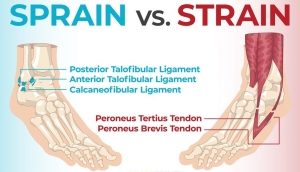Sprains Treatment in Jaipur
Sprains, strains, and contusions are common injuries that can occur during physical activities, sports, or accidents, leading to pain, swelling, bruising, and limited mobility. Seeking timely treatment for these injuries is essential to prevent further damage and ensure a proper healing process. Dr. Arvind Jaga’s physiotherapy clinic offers sprains treatment in Jaipur, provided by a team of experienced physiotherapists who utilize various techniques to facilitate patients’ recovery.
The initial step in treating these injuries is to accurately diagnose the extent of the injury. The physiotherapists employ a combination of physical examinations, imaging tests, and patient history to determine the severity of the injury and devise a personalized treatment plan.
For strains treatment, the options may include manual therapy techniques, such as massage and joint mobilization, to alleviate pain and improve mobility. Exercise programs are tailored to help patients regain strength and flexibility in the affected area. The team may also use modalities like ultrasound and electrical stimulation to promote healing and reduce inflammation.
In addition to these treatments, education on proper injury management techniques and injury prevention strategies is provided. This includes guidance on proper body mechanics during physical activities, appropriate warm-up and cool-down routines, and the use of protective equipment.
Dr. Arvind Jaga Physiotherapists are dedicated to assisting patients in recovering from their injuries and achieving optimal physical function. If you are experiencing a sprain, strain, or contusion, don’t hesitate to contact the clinic to schedule an appointment and begin your path to recovery.
 What is a sprain:
What is a sprain:
A sprain is an injury to a ligament, which is a tough band of tissue connecting bone to bone and providing stability to a joint. Sprains usually occur when a joint is forced beyond its normal range of motion, leading to the stretching or tearing of the ligament. These injuries are common in sports and physical activities and can vary in severity from mild to severe. Seeking prompt medical attention if a sprain is suspected is crucial to ensure proper treatment and prevent further damage to the affected joint. Early intervention can aid in a more successful recovery and reduce the risk of long-term complications.
What is a strain:
A strain refers to a stretched or torn muscle or tendon, which are the fibrous tissues that connect muscles to bones. Strains typically occur when the muscle or tendon is stretched beyond its limit, causing damage to the fibers. Common causes of strains include overuse, sudden movements, and poor posture. Symptoms of a strain may include pain, stiffness, swelling, bruising, and difficulty moving the affected area. Mild strains may heal on their own with rest, while more severe strains may require medical attention and treatment such as physiotherapy, stretching exercises, and pain management techniques.
symptoms of a sprain or strain:
The symptoms of a sprain may indeed include pain, swelling, bruising, and difficulty using the affected joint or limb. In some cases, a popping or tearing sensation may also be experienced at the time of the injury.
On the other hand, the symptoms of a strain may involve muscle pain, weakness, muscle spasms, and cramping. The severity of these symptoms may vary based on the extent of the injury. Seeking medical attention promptly if a sprain or strain is suspected is crucial as untreated injuries can lead to further complications.
Pain in the injured area, with the child likely guarding or protecting the affected region from being touched or examined.
Swelling in the injured area.
Difficulty using or moving the injured area normally. For instance, the child may have limited use or may not use the injured area at all, and if the injury occurred in the hip, leg, ankle, or foot area, they may walk with a limp.
It is essential to note that the symptoms of a sprain or strain may resemble other conditions, so it is always advisable to consult a physician for an accurate diagnosis and appropriate treatment.
Treatment for sprains or strains:
The treatment plan will depend on the extent of the injury and the affected area.
Some common treatment options for sprains and strains include rest, ice, compression, and elevation (RICE). This approach can help reduce pain and swelling in the affected area. In addition, physiotherapy and exercise programs can help improve range of motion and strength in the injured area.
In more severe cases, Dr. Jaga may recommend the use of braces, crutches, or other assistive devices to support the injured area and promote healing. Pain management techniques such as massage therapy, heat therapy, and electrical stimulation may also be used to alleviate discomfort.
If the sprain or strain is severe or does not respond to non-invasive treatments, surgery may be required. Dr. Jaga is experienced in performing various surgical procedures to repair damaged ligaments, tendons, or muscles.
Overall, the goal of treatment for sprains and strains is to reduce pain, improve function, and promote healing. Dr. Jaga and his team will work with patients to develop a personalized treatment plan that addresses their unique needs and goals.
